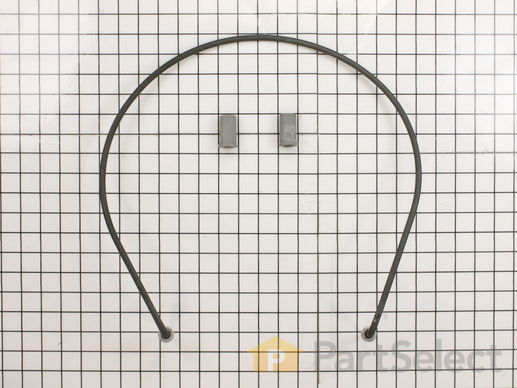Appliance Parts
Instant Repairman
Enter your model number and our Instant Repairman will help diagnose and fix your appliance
How to test a dishwasher's heating element:
 | Testing a heating element
Locate your dishwasher's heating element. Open the dishwasher door and look into the tub. It is the thin, circular tube at the base of your dishwasher. It may or may not be covered. If it is covered, remove the lower dishrack, and then remove the cover. Your heating element is going to have two metal terminals. One at each end. Each terminal reaches downwards, into the base of the dishwasher. Mentally mark the area where each terminal enters the base of the tub. Now you need to gain access to the heating element's wiring. You can do this by first removing the lower kickplate panel of the dishwasher. There will be at least two screws (but maybe four) holding the kickplate panel in place. They are located either on the top or the bottom of the panel. If the screws are located on the top, you may need to open the dishwasher door in order to gain access to them. Close the door to remove the panel, though. Now look into the lower access area that you have just uncovered. Pinpoint the area where the heating element terminals extend through the base of the dishwasher. They will each have a wire connected to it. Label each of the wires so that you will be able to properly reconnect them later. Now you can pull the wires off the terminals. Each wire is connected to a terminal using a slip-on connector. Grasp the connector and pull on it firmly. DO NOT pull on the wire itself. Pull only from the connector. You may decide you need to use a pair of needle nosed pliers to help you. Use your multitester (aka multimeter) to test the heating element for continuity. Set the device to the ohms setting x 1. Touch each meter probe to a terminal. You should receive a reading somewhere in between infinity and zero. Because of the variety of makes and models of dishwashers, it is quite difficult to say exactly what the reading should be for each and every possible model. However, if the test you conduct produces a reading of infinite resistance (meter's needle does not move), then that is indicative of a faulty heating element, and you should replace yours. Similarily, if the test you conduct produces a reading of zero resistance (meter's needle moves to the other extreme of the scale), then that is also indicative of a faulty heating element, and you should replace yours. You do not have to remove the heating element from the dishwasher in order to test it. Just make sure power is not getting to your dishwasher before you conduct the test. | ||


























